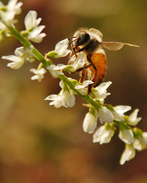
In recent years, human development has threatened or eliminated many species that were once prevalent in the landscape. As our society continues to expand into previously unmaintained wild areas, increasing pressure is placed on native wildlife. For this reason, there is no better time than the present for gardeners to recognize the important role they play in the future of land management and conservation.
Gardeners, and the general public alike, need to begin to think of their backyards as living entities, made up of millions of interdependent parts. Gardeners hoping to create real habitat that will help to restore critical pieces of our ecosystem need to plant the species that support all wildlife: bees, flies, grasshoppers, bugs, butterflies, beetles, spiders and wasps. While it is easy to overlook many of the smaller creepy crawlies, we must remind ourselves that in absence of these smaller creatures the complex ecosystem crumbles.
Gardeners, and the general public alike, need to begin to think of their backyards as living entities, made up of millions of interdependent parts. Gardeners hoping to create real habitat that will help to restore critical pieces of our ecosystem need to plant the species that support all wildlife: bees, flies, grasshoppers, bugs, butterflies, beetles, spiders and wasps. While it is easy to overlook many of the smaller creepy crawlies, we must remind ourselves that in absence of these smaller creatures the complex ecosystem crumbles.
Unfortunately, people hoping to create gardens that provide habitat often miss the mark. Take for example the popular “bird garden.” Many bird lovers, in an effort to attract birds to their garden, plant a few select shrubs that provide berries for these winged beauties, while failing to consider the many less obvious species that are necessary to sustain a healthy bird population. Approximately 96 of all the terrestrial bird species in North America rely on insects and other arthropods (typically spiders) to feed their young (Tallamy, 21).
Creating a true habitat that maintains biodiversity involves more than just planting a couple of berry and nectar producing shrubs. A habitat garden supports a complex web of creatures, large and microscopic, that make up a living community. Habitat gardens offer four important resources: food, water, shelter and nesting sites.
FOOD
Food is usually the first thing people think of when they are creating a habitat garden and while this may seem simple and straightforward, there are a couple of points worthy of reinforcement. Gardeners hoping to provide habitat must remember that the needs of each specie vary according to its individual life cycle. For example, while butterflies need nectar, in the larval stage of their life cycle (when they are caterpillars) they will feed on foliage, flowers and seeds. In addition, caterpillars (unlike butterflies) are very selective when choosing their host plant. The Spicebush Swallowtail Butterfly in its caterpillar form will only feed on the Spicebush, Lindera benzoin. Dietary requirements of species change with the seasons as well. A well-designed habitat garden will provide a food source in every season. Trees and shrubs that hold their fruit into the winter are extremely important for migrating birds and small mammals that winter over. Eastern Red Cedar, American Cranberry, Red Chokeberry, Winterberry Holly and Staghorn Sumac are just a few species that provide food throughout the winter. Of course one could also supplement with feeders, but this requires a certain level of commitment and feed is a reoccurring expense.
WATER
Water is a necessity for all life. If you are fortunate enough to have a spring, stream, pond or vernal pool on your property make every effort to maintain it and protect it from pollutants. Vernal pools are shallow depressions that collect snow melt and other runoff. Due to their small size and their tendency to dry up in summer, these pools do not contain fish, but are important breeding areas for frogs, salamanders and many invertebrate species. In areas where naturally occurring water is not present, gardeners should provide an accessible water source in the form of a simple birdbath or artificial pond.
SHELTER & NEST SITES
Shelter from the elements is critical to the survival of wildlife in the winter. Eastern Red Cedar, Juniper and White Pine are a few of the species that can provide protection from harsh weather. When snow blankets the ground the bare spots underneath conifer trees can provide important foraging sites for birds and small mammals. Dead and decaying trees are great for wildlife because they provide hollows for nest sites and are often home to many insects. Brush piles and thickets offer shelter and nest sites for many species. In addition, they can serve as important protection from predators. Shelter and nest sites can also come in the form of human-made bat houses, nest boxes, bee hives or nesting blocks. The Brooklyn Botanical Garden published a small book called The Wildlife Gardener’s Guide which includes simple instructions for building some of these artificial shelters. Many of these can be great rainy-day projects for parents and children.
TIPS TO INCREASE BACKYARD HABITAT
1. Do not plant invasive or potentially invasive species. Consider native alternatives that will support, not threaten, the ecosystem. For example, there are a number of alternatives to the popular, yet invasive, Burning Bush. Some native alternatives would be Red Chokeberry (Aronia arbutifolia), Red Oiser Dogwood (Cornus sericea), Highbush Blueberry (Vaccinium corybosum), or Spicebush (Lindera benzoin).
2. Ask your nursery or garden center how they obtain their plants. Make sure their stock comes from seed or cuttings obtained in an environmentally responsible manner. Never dig plants from the wild!
3. If you want to create habitat and preserve biodiversity you must forego perfection. Habitat gardens will have flaws. Bugs will munch on leaves; they are supposed to! When we create habitat where all native species are allowed to thrive, natural ecological systems balance out and predators will keep insect populations in check.
4. Do not use fertilizers and non-organic pesticides. Wildlife is often inadvertently harmed by gardeners who fail to recognize how toxic these products can be.
FOR MORE INFORMATION
For more detailed information on habitat gardening check out the following books:
- Bringing Nature Home: How Native Plants Sustain Wildlife in Our Gardens by Douglas W. Tallamy
- Enhancing Your Backyard Habitat for Wildlife by Peter M. Picone (CT Department of Environmental Protection)
- Bringing Nature Home by Douglas Tallamy
- The Wildlife Gardener’s Guide by Janet Marinelli (Brooklyn Botanical Garden)
Creating a true habitat that maintains biodiversity involves more than just planting a couple of berry and nectar producing shrubs. A habitat garden supports a complex web of creatures, large and microscopic, that make up a living community. Habitat gardens offer four important resources: food, water, shelter and nesting sites.
FOOD
Food is usually the first thing people think of when they are creating a habitat garden and while this may seem simple and straightforward, there are a couple of points worthy of reinforcement. Gardeners hoping to provide habitat must remember that the needs of each specie vary according to its individual life cycle. For example, while butterflies need nectar, in the larval stage of their life cycle (when they are caterpillars) they will feed on foliage, flowers and seeds. In addition, caterpillars (unlike butterflies) are very selective when choosing their host plant. The Spicebush Swallowtail Butterfly in its caterpillar form will only feed on the Spicebush, Lindera benzoin. Dietary requirements of species change with the seasons as well. A well-designed habitat garden will provide a food source in every season. Trees and shrubs that hold their fruit into the winter are extremely important for migrating birds and small mammals that winter over. Eastern Red Cedar, American Cranberry, Red Chokeberry, Winterberry Holly and Staghorn Sumac are just a few species that provide food throughout the winter. Of course one could also supplement with feeders, but this requires a certain level of commitment and feed is a reoccurring expense.
WATER
Water is a necessity for all life. If you are fortunate enough to have a spring, stream, pond or vernal pool on your property make every effort to maintain it and protect it from pollutants. Vernal pools are shallow depressions that collect snow melt and other runoff. Due to their small size and their tendency to dry up in summer, these pools do not contain fish, but are important breeding areas for frogs, salamanders and many invertebrate species. In areas where naturally occurring water is not present, gardeners should provide an accessible water source in the form of a simple birdbath or artificial pond.
SHELTER & NEST SITES
Shelter from the elements is critical to the survival of wildlife in the winter. Eastern Red Cedar, Juniper and White Pine are a few of the species that can provide protection from harsh weather. When snow blankets the ground the bare spots underneath conifer trees can provide important foraging sites for birds and small mammals. Dead and decaying trees are great for wildlife because they provide hollows for nest sites and are often home to many insects. Brush piles and thickets offer shelter and nest sites for many species. In addition, they can serve as important protection from predators. Shelter and nest sites can also come in the form of human-made bat houses, nest boxes, bee hives or nesting blocks. The Brooklyn Botanical Garden published a small book called The Wildlife Gardener’s Guide which includes simple instructions for building some of these artificial shelters. Many of these can be great rainy-day projects for parents and children.
TIPS TO INCREASE BACKYARD HABITAT
1. Do not plant invasive or potentially invasive species. Consider native alternatives that will support, not threaten, the ecosystem. For example, there are a number of alternatives to the popular, yet invasive, Burning Bush. Some native alternatives would be Red Chokeberry (Aronia arbutifolia), Red Oiser Dogwood (Cornus sericea), Highbush Blueberry (Vaccinium corybosum), or Spicebush (Lindera benzoin).
2. Ask your nursery or garden center how they obtain their plants. Make sure their stock comes from seed or cuttings obtained in an environmentally responsible manner. Never dig plants from the wild!
3. If you want to create habitat and preserve biodiversity you must forego perfection. Habitat gardens will have flaws. Bugs will munch on leaves; they are supposed to! When we create habitat where all native species are allowed to thrive, natural ecological systems balance out and predators will keep insect populations in check.
4. Do not use fertilizers and non-organic pesticides. Wildlife is often inadvertently harmed by gardeners who fail to recognize how toxic these products can be.
FOR MORE INFORMATION
For more detailed information on habitat gardening check out the following books:
- Bringing Nature Home: How Native Plants Sustain Wildlife in Our Gardens by Douglas W. Tallamy
- Enhancing Your Backyard Habitat for Wildlife by Peter M. Picone (CT Department of Environmental Protection)
- Bringing Nature Home by Douglas Tallamy
- The Wildlife Gardener’s Guide by Janet Marinelli (Brooklyn Botanical Garden)

 RSS Feed
RSS Feed

